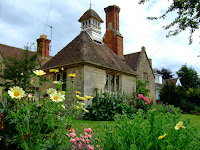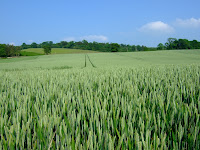 Despite a week of flooding around the Midlands, and a heavy rain warning for parts of England, we headed up to Birmingham for the weekend. Months ago, when the accommodation was booked, we had visions of a sunny June evening beside the Birmingham canals. Birmingham claims to have more canals than Venice, and they do make the city interesting. (However, Venice still wins in the ‘desirable holiday destination’ stakes.)
Despite a week of flooding around the Midlands, and a heavy rain warning for parts of England, we headed up to Birmingham for the weekend. Months ago, when the accommodation was booked, we had visions of a sunny June evening beside the Birmingham canals. Birmingham claims to have more canals than Venice, and they do make the city interesting. (However, Venice still wins in the ‘desirable holiday destination’ stakes.)By the time we reached Birmingham, the heavy rain had eased; nevertheless we were pleased our first stop was indoors. Near the centre of the city is an area known as the Jewellery Quarter.
 The Council own a property that was a jewellery factory for over a hundred years. It was owned by one family, and when the children of the founder were in their 70's and wanting to retire, they were unable to find a buyer, so, in 1981, just shut the doors. 10 years later the council heard about and decided to turn it into a museum. Thus it is exactly as they left it, down to the many plugs in one socket and marmite and jam in the fridge. The tour gave a very interesting insight into life during the last 100 years, and I recognised a gold bracelet design from my childhood - a bamboo design.
The Council own a property that was a jewellery factory for over a hundred years. It was owned by one family, and when the children of the founder were in their 70's and wanting to retire, they were unable to find a buyer, so, in 1981, just shut the doors. 10 years later the council heard about and decided to turn it into a museum. Thus it is exactly as they left it, down to the many plugs in one socket and marmite and jam in the fridge. The tour gave a very interesting insight into life during the last 100 years, and I recognised a gold bracelet design from my childhood - a bamboo design. After walking the jewellery trail, we visited Soho House, the home of Matthew Boulton; a prominent manufacturer. He was responsible for getting a local assay office, so the jewellers could have their items hallmarked locally.
After walking the jewellery trail, we visited Soho House, the home of Matthew Boulton; a prominent manufacturer. He was responsible for getting a local assay office, so the jewellers could have their items hallmarked locally. By this stage in the afternoon, the rain had stopped, so we were able to have a look around the canals in the centre of town. The whole area has been redeveloped and is lovely, even on a grim grey day, it must be a very pleasant place to spend a warm June evening, with cafe's and pubs all along the canal side.
By this stage in the afternoon, the rain had stopped, so we were able to have a look around the canals in the centre of town. The whole area has been redeveloped and is lovely, even on a grim grey day, it must be a very pleasant place to spend a warm June evening, with cafe's and pubs all along the canal side. We had read that a trip to the Balti Triangle is a must for eating out in Birmingham. So we tore ourselves away from the huge selection of eating-places in the centre, and drove to southeast Birmingham, to find the Balti Triangle. This is a dish made popular locally by the many immigrants. The chosen Balti is cooked in an iron dish and brought steaming hot, straight to the table. After complimentary popadums with very tasty dips, our chosen dishes (one lamb & one chicken) arrived. Enough to feed a family of four, but so delicious we were obliged to finish it all, washed down with a scrummy mango lassi.
We had read that a trip to the Balti Triangle is a must for eating out in Birmingham. So we tore ourselves away from the huge selection of eating-places in the centre, and drove to southeast Birmingham, to find the Balti Triangle. This is a dish made popular locally by the many immigrants. The chosen Balti is cooked in an iron dish and brought steaming hot, straight to the table. After complimentary popadums with very tasty dips, our chosen dishes (one lamb & one chicken) arrived. Enough to feed a family of four, but so delicious we were obliged to finish it all, washed down with a scrummy mango lassi. Now that the rain had decided to stay away, we stopped at Bournville, on the way to our hotel. The Cadburys (as in Cadburys Chocolate) built this picture-book town for their workers around the end of the 19th C. Like many of the great Quaker industrialists, the Cadburys were concerned for their workers health, social and educational well-being.
Now that the rain had decided to stay away, we stopped at Bournville, on the way to our hotel. The Cadburys (as in Cadburys Chocolate) built this picture-book town for their workers around the end of the 19th C. Like many of the great Quaker industrialists, the Cadburys were concerned for their workers health, social and educational well-being.  The village was having their annual fete on the green, and the whole place looked like a mocked up tourist attraction.
The village was having their annual fete on the green, and the whole place looked like a mocked up tourist attraction.








































